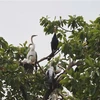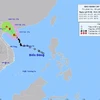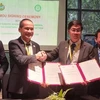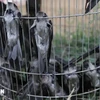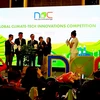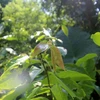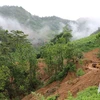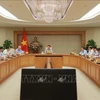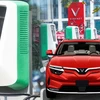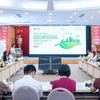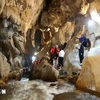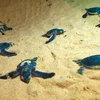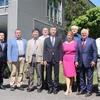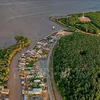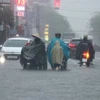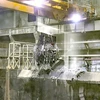Local communities must be involved in nature conservation within biosphere reserves and at World Natural Heritage Sites in Vietnam to ensure biodiversity is protected.
That was the conclusion of environmental experts attending a workshop in Hanoi on March 9 organised by the United Nations Educational, Scientific and Cultural Organisation (UNESCO) on conservation strategies for Vietnam.
A biosphere is established to conserve biodiversity by protecting natural resources. It was noted at the seminar that in many protected areas, wildlife conservation typically involved prohibiting or limiting the use of natural resources on which local communities rely for their livelihood for generations.
This approach poses a significant threat to local residents, who are often forced to leave their home to seek employment opportunities elsewhere. In addition, many traditional practices are being threatened by current conservation practices, the seminar heard.
That is why the impacts of resource-management decisions on local livelihoods must be considered. A more sustainable approach, the participants agreed, is to engage the local communities rather than get them to "stand there as a guard to protect the areas".
Katherine Muller-Marin, UNESCO representative to Vietnam, said: "Many local communities live in and around biosphere reserves and world heritage areas and have rich inter-generational knowledge about the sustainable use of natural resources.
"That's why it's important that the traditional knowledge of communities living near such sites is safeguarded and integrated into local livelihood development initiatives."
Vo Chi Trung, from Vietnam Man and Biodiversity National Committee, said it is not until recently that we have realised the importance of local ingenuity in conservation. Although it was first mentioned two decades ago, its application has been insignificant because such wisdom has not effectively translated into policies.
"When it comes to the effective use of natural resources, local people know best." He cited the example of U Minh Melaleuca forest where in the upper part there has been numerous fires, while in the lower section there has been very few.
"The secret for this remarkable fact is that in the lower U Minh bee keepers rely on the Melaleuca trees. They know very well how the wind changes and can help to very effectively prevent forest fires," he said.
He said local people should be enlisted to protect the local environment rather than forest rangers because they knew the local environment best.
This view was echoed by Nguyen Manh Hiep, from the Directorate of Forestry's Nature Conservation Department. He said local residents should be closely involved in protecting the natural environment because there are only 10,000 forest rangers in the country but 40 million people whose lives depend on forests for their livelihood.
From September 2009 to June 2012, a UNESCO-led pilot project in four biosphere reserves in Ca Mau, Hai Phong, Dong Nai and Nghe An was designed to encourage local communities to develop non-timber forestry products and practise eco-tourism and participate in planning and zoning within buffer zones./.
That was the conclusion of environmental experts attending a workshop in Hanoi on March 9 organised by the United Nations Educational, Scientific and Cultural Organisation (UNESCO) on conservation strategies for Vietnam.
A biosphere is established to conserve biodiversity by protecting natural resources. It was noted at the seminar that in many protected areas, wildlife conservation typically involved prohibiting or limiting the use of natural resources on which local communities rely for their livelihood for generations.
This approach poses a significant threat to local residents, who are often forced to leave their home to seek employment opportunities elsewhere. In addition, many traditional practices are being threatened by current conservation practices, the seminar heard.
That is why the impacts of resource-management decisions on local livelihoods must be considered. A more sustainable approach, the participants agreed, is to engage the local communities rather than get them to "stand there as a guard to protect the areas".
Katherine Muller-Marin, UNESCO representative to Vietnam, said: "Many local communities live in and around biosphere reserves and world heritage areas and have rich inter-generational knowledge about the sustainable use of natural resources.
"That's why it's important that the traditional knowledge of communities living near such sites is safeguarded and integrated into local livelihood development initiatives."
Vo Chi Trung, from Vietnam Man and Biodiversity National Committee, said it is not until recently that we have realised the importance of local ingenuity in conservation. Although it was first mentioned two decades ago, its application has been insignificant because such wisdom has not effectively translated into policies.
"When it comes to the effective use of natural resources, local people know best." He cited the example of U Minh Melaleuca forest where in the upper part there has been numerous fires, while in the lower section there has been very few.
"The secret for this remarkable fact is that in the lower U Minh bee keepers rely on the Melaleuca trees. They know very well how the wind changes and can help to very effectively prevent forest fires," he said.
He said local people should be enlisted to protect the local environment rather than forest rangers because they knew the local environment best.
This view was echoed by Nguyen Manh Hiep, from the Directorate of Forestry's Nature Conservation Department. He said local residents should be closely involved in protecting the natural environment because there are only 10,000 forest rangers in the country but 40 million people whose lives depend on forests for their livelihood.
From September 2009 to June 2012, a UNESCO-led pilot project in four biosphere reserves in Ca Mau, Hai Phong, Dong Nai and Nghe An was designed to encourage local communities to develop non-timber forestry products and practise eco-tourism and participate in planning and zoning within buffer zones./.
